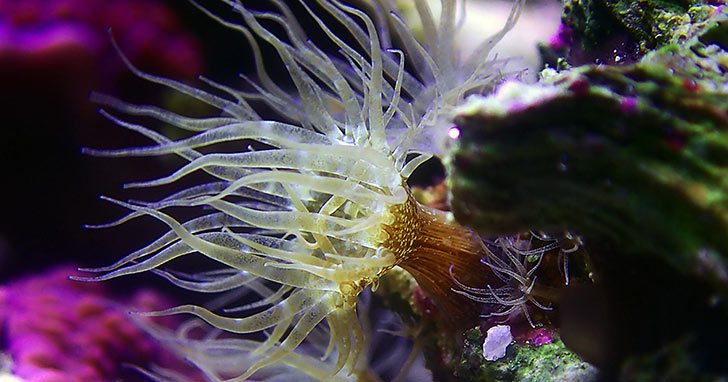
Aiptasia: Recognizing and Understanding This Stinging CnidarianIntroduction to Aiptasia
Most saltwater enthusiasts at some point in their hobby experience have dealt with the Aiptasia anemone. In this two-part series on Aiptasia, we discuss how this hardy and survival-oriented organism is able to thrive in your aquarium and the different methods you can use for its removal. What is Aiptasia?
A common and unwanted guest in saltwater aquariums, Aiptasia, also known as Glass, Rock, Tube, or Glass Rose anemones, are capable of multiplying rapidly and competing for food and space aggressively. They often hitchhike in reef rock or on coral colonies, waiting for the ideal time to multiply in your aquarium. These opportunistic anemones can be identified by their resemblance to miniature palm trees, with a polyp body and an oral disc bordered by tentacles. There are many different species of Aiptasia; some varieties are transparent, while others are mostly light brown or tan in color, ranging in size from a few centimeters to a few inches. The brown color of most Aiptasia found in aquariums is due to a symbiotic relationship with zooxanthellae, tiny algae cells living within the Aiptasia's tissue that provide the anemone with much of its nutrients and energy Like all members of the Cnidaria phylum, Aiptasia have the ability to sting for both offensive and defensive purposes; the tentacles near the oral disc have stinging cells called nematocysts that can sting fish, crustaceans, corals, and reef rock in your aquarium. As an added defensive mechanism, Aiptasia can also withdraw into tiny holes in your reef rock if threatened. Aiptasia are tenacious survivors
Aiptasia reproduce rapidly and have the ability to do so both sexually and asexually. This asexual reproduction is referred to as pedal laceration. During pedal laceration, tiny basal cells break off the Aiptasia to colonize elsewhere in the tank - on reef rock, substrate, aquarium walls, even on equipment. This sometimes happens when physical removal of the Aiptasia polyp is attempted, often resulting in creating more Aiptasia polyps than existed originally. Despite the difficulty involved with removing Aiptasia, you want to rid your aquarium of the anemones before the Aiptasia population gets out of control. Part 2 in this series will show you ways to effectively reduce your Aiptasia population. Related Articles
|
|
|


